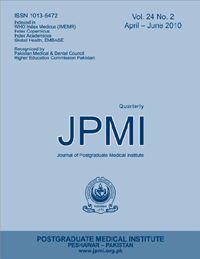FACTORS AFFECTING MEDICAL SPECIALTY PREFERENCES AND ASSOCIATED GENDER DIFFERENCES IN FOURTH YEAR MBBS STUDENTS
Main Article Content
Abstract
Objective: To identify factors affecting medical specialty preferences and associated gender differences in
Fourth Year MBBS students.
Material and Methods: This was a Cross-sectional survey conducted on fourth year MBBS students of
Lahore Medical and Dental College through a Preformed Structured questionnaire by non probability
sampling technique. The student were told that the survey was voluntary and were given a choice of refusal
but fortunately all the students in the class participated in the survey (n=120). Data was collected during
January 2009. Data was analyzed using SPSS v. 16.0. Descriptive statistics were computed, and the
relationship between specialty preference and categorical variables (gender, reasons for choosing a
particular specialty) were evaluated using Pearson Chi square test. A calculated p value of < 0.05 was
considered statistically significant.
Results: Our study revealed that students selected surgery [40(33%)] as the most preferred post graduate
specialty followed by medicine [17(14%)] and Obstetrics/Gynecology [16(13%)] respectively. Female
medical students picked Obstetrics /Gynecology [16(24%)] while male medical students opted for Surgery
as their most preferred specialty [28 (51%)]. This gender difference in specialty preference was
statistically significant with a p value of < 0.00.
The most common reasons for choosing a particular specialty were reputation (general perception among
people) of the specialty [46(38%)] and anticipated income [22(18%)].
Conclusion: The most common reasons cited by students for choosing a particular specialty was reputation
of the specialty followed by anticipated income and advice from parents. Gender differences were found in
career preferences.
Fourth Year MBBS students.
Material and Methods: This was a Cross-sectional survey conducted on fourth year MBBS students of
Lahore Medical and Dental College through a Preformed Structured questionnaire by non probability
sampling technique. The student were told that the survey was voluntary and were given a choice of refusal
but fortunately all the students in the class participated in the survey (n=120). Data was collected during
January 2009. Data was analyzed using SPSS v. 16.0. Descriptive statistics were computed, and the
relationship between specialty preference and categorical variables (gender, reasons for choosing a
particular specialty) were evaluated using Pearson Chi square test. A calculated p value of < 0.05 was
considered statistically significant.
Results: Our study revealed that students selected surgery [40(33%)] as the most preferred post graduate
specialty followed by medicine [17(14%)] and Obstetrics/Gynecology [16(13%)] respectively. Female
medical students picked Obstetrics /Gynecology [16(24%)] while male medical students opted for Surgery
as their most preferred specialty [28 (51%)]. This gender difference in specialty preference was
statistically significant with a p value of < 0.00.
The most common reasons for choosing a particular specialty were reputation (general perception among
people) of the specialty [46(38%)] and anticipated income [22(18%)].
Conclusion: The most common reasons cited by students for choosing a particular specialty was reputation
of the specialty followed by anticipated income and advice from parents. Gender differences were found in
career preferences.
Article Details
How to Cite
1.
Hashmi NR, Daud S, Manzoor I, Maqsood S, Aizaz S, Siddiqui D, et al. FACTORS AFFECTING MEDICAL SPECIALTY PREFERENCES AND ASSOCIATED GENDER DIFFERENCES IN FOURTH YEAR MBBS STUDENTS. J Postgrad Med Inst [Internet]. 2011 Oct. 13 [cited 2026 Jan. 2];24(2). Available from: https://jpmi.org.pk/index.php/jpmi/article/view/1225
Issue
Section
Original Article
Work published in JPMI is licensed under a
Creative Commons Attribution-NonCommercial 2.0 Generic License.
Authors are permitted and encouraged to post their work online (e.g., in institutional repositories or on their website) prior to and during the submission process, as it can lead to productive exchanges, as well as earlier and greater citation of published work.


